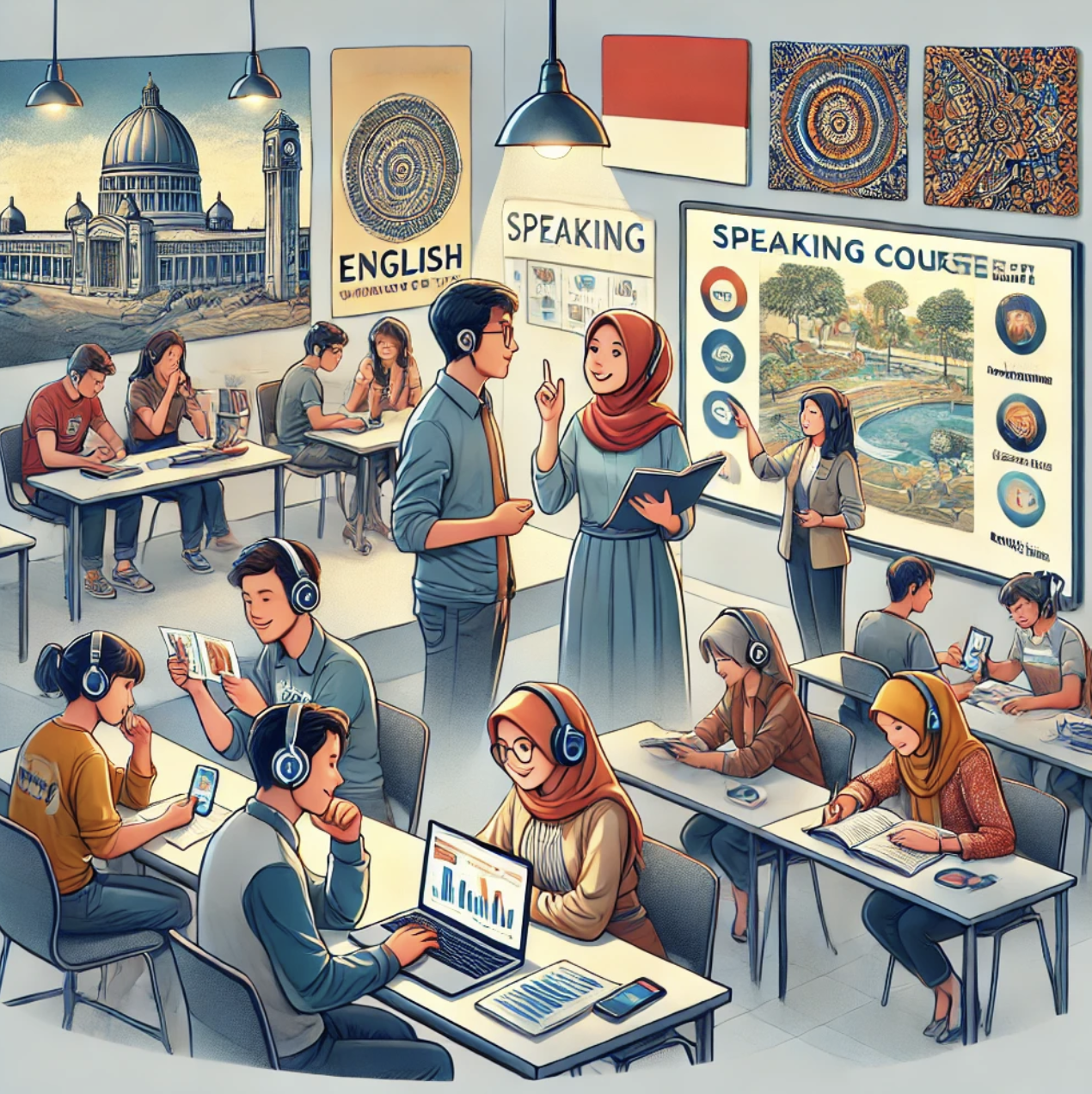A Study on Students’ Learning Styles In Speaking Course At The English Department of Widya Gama Mahakam University, Samarinda
DOI:
https://doi.org/10.24903/bej.v7i2.2140Keywords:
Learning styles, speaking course, visual learners, auditory learners, kinesthetic learners, English as Foreign Language (EFL)Abstract
This study investigates students' learning styles in the Speaking Course at the English Department of Widya Gama Mahakam University, Samarinda. The research aimed to identify problems faced by students when using their learning styles and analyze the advantages and disadvantages of different learning styles in speaking development. The study employed a qualitative case study design with six purposively selected fourth-semester students representing visual, auditory, and kinesthetic learning styles. Data were collected through semi-structured interviews and analyzed using thematic analysis with theory triangulation for validation. For thematic analysis, we followed Braun and Clarke's six-phase framework, and for the theory triangulation, applied Fleming's VARK model. The findings revealed distinct learning style preferences that significantly influenced speaking course. Visual learners demonstrated strong preparation and organizational skills but struggled with spontaneous conversations and real-time communication. Auditory learners showed excellent listening abilities and natural speaking fluency but faced challenges with written preparation and environmental distractions. Kinesthetic learners excelled in interactive activities and experiential learning but encountered difficulties in traditional classroom settings and abstract discussions. Each learning style group faced specific challenges: visual learners experienced anxiety in unstructured speaking situations and over-dependence on visual supports; auditory learners struggled with spelling and written organization; kinesthetic learners had difficulties with sedentary learning environments. Despite their strengths, each learning style demonstrated notable limitations in comprehensive speaking development. The research contributes to understanding the relationship between learning styles and speaking skill acquisition in EFL contexts. The result is that while learning style preferences should be accommodated, students need multimodal learning strategies to overcome single-modality limitationsReferences
Al-dheleai, Y. M., Baki, R., Tasir, Z., & Al-rahmi, W. M. (2019). What hinders the use of ICT among academic staff at Yemen’s public universities? International Journal of Humanities and Innovation (IJHI), 2(1). https://doi.org/10.33750/IJHI.V2I1.30
Alnujaidi, S. (2018). The Relationship Between EFL Students’ Perceptual Learning Styles and Their Language Learning Strategies in Saudi Arabia. International Journal of English Linguistics, 9(1). https://doi.org/10.5539/ijel.v9n1p69
Alzain, A. M., Clark, S., Jwaid, A., & Ireson, G. (2018). Adaptive education based on learning styles: Are learning style instruments precise enough? International Journal of Emerging Technologies in Learning, 13(9). https://doi.org/10.3991/ijet.v13i09.8554
Ary, D., Jacobs, L. C., Irvine, S. C. K., & Walker, D. (2018). Introduction to Research in Education. Cengage Learning.
Braun, V., & Clarke, V. (2006). Using thematic analysis in psychology. Qualitative Research in Psychology, 3(2), 77-101. https://doi.org/10.1191/1478088706qp063oa
Cohen., L., & Et.al. (2007). Research Method in Education, sixth edition. Rutledge.
Creswell. (2003). Creswell, J.W. (2003). Chapter One, “A Framework for Design.” Research Design Qualitative Quantitative and Mixed Methods Approaches. https://doi.org/10.3109/08941939.2012.723954
Faridah, D. N. (2019). THE RELATIONSHIP BETWEEN STUDENTS’ LEARNING STYLE AND THEIR ACHIEVEMENT IN LISTENING SKILL. Syarif Hidayatullah State Islamic University Jakarta.
Fiorilli, C., Gay, P., Romano, L., Tchounwou, P. B., Zheng, S., & Zhou, X. (2022). Enhancing Foreign Language Enjoyment through Online Cooperative Learning: A Longitudinal Study of EFL Learners. International Journal of Environmental Research and Public Health 2023, Vol. 20, Page 611, 20(1), 611. https://doi.org/10.3390/IJERPH20010611
Fleming, N. D. (2016). VARK a guide to learning styles. Research & statistics. A Guide To Learning Styles.
Guest, G., Namey, E. E., & Mitchell, M. L. (2017). Collecting Qualitative Data: A Field Manual for Applied Research. In Collecting Qualitative Data: A Field Manual for Applied Research. SAGE Publications, Ltd. https://doi.org/10.4135/9781506374680
Hollweck, T. (2016). Robert K. Yin. (2014). Case Study Research Design and Methods (5th ed.). Thousand Oaks, CA: Sage. 282 pages. The Canadian Journal of Program Evaluation. https://doi.org/10.3138/cjpe.30.1.108
Honorene, J. (2017). Understanding The Role of Triangulation in Research. Scholarly Research Journal for Interdisciplinary Studies, 4(6), 31. https://doi.org/2278-8808
Hung, N. V. (2012). Mother tongue use in task-based language teaching model. English Language Teaching. https://doi.org/10.5539/elt.v5n8p23
Lahdenperä, J., Rämö, J., & Postareff, L. (2022). Student-centred learning environments supporting undergraduate mathematics students to apply regulated learning: A mixed-methods approach. Journal of Mathematical Behavior, 66, 100949. https://doi.org/10.1016/j.jmathb.2022.100949
Lwande, C., Muchemi, L., & Oboko, R. (2021). Identifying learning styles and cognitive traits in a learning management system. Heliyon, 7(8). https://doi.org/10.1016/j.heliyon.2021.e07701
Mahnegar, F. (2012). Learning Mangement System. International Journal of Business and Social Science, 3(12), 144–151.
Miles, M. B., Huberman, A. M., & Saldana, J. (2014). Qualitative Data Analysis A Methods Sourcebook. Sage.
Nafis, H. (2017). STUDENTS’ PREFERENCE OF LANGUAGE LEARNING STYLE IN ENGLISH CLASSROOM. Educational Psychology Journal, 2(2).
Patton, M. Q. (2002). Qualitative Research and Evaluation Methods. Sage Publications.
Rao, Z., Yongqi Gu, P., Jun Zhang, L., & Hu, G. (2007). Reading strategies and approaches to learning of bilingual primary school pupils. Language Awareness, 16(4), 243–262. https://doi.org/10.2167/la423.0
Reid, J. M. (1995). Learning styles in the ESL / EFL classroom. Preface.
Serhan, D. (2020). Transitioning from Face-to-Face to Remote Learning: Students’ Attitudes and Perceptions of using Zoom during COVID-19 Pandemic. International Journal of Technology in Education and Science, 4(4), 335–342. https://doi.org/10.46328/ijtes.v4i4.148
Shamsuddin, N., & Kaur, J. (2020). Students’ learning style and its effect on blended learning, does it matter? International Journal of Evaluation and Research in Education, 9(1). https://doi.org/10.11591/ijere.v9i1.20422
Wilson, M. L. (2012). Students’ Learning Style Preferences and Teachers’ Instructional Strategies: Correlations Between Matched Styles and Academic Achievement. SRATE Journal, 22(1).
Yang, X., Shi, F., Liu, X., & Zhao, Y. (2016). Learning styles and perceptual patterns for English /i/ and /I/ among Chinese college students. Applied Psycholinguistics, 37(3). https://doi.org/10.1017/S014271641500020X

Downloads
Published
How to Cite
Issue
Section
License
Copyright (c) 2025 Rahmaniah, Hasbi Sjamsir, Iwan Setiawan

This work is licensed under a Creative Commons Attribution 4.0 International License.
Authors retain copyright and grant the journal right of first publication with the work simultaneously licensed under a Creative Commons Attribution 4.0 International License that allows others to share the work with an acknowledgment of the work's authorship and initial publication in this journal.



